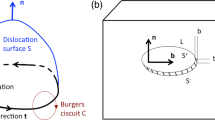Abstract
The total energy of a wedge-shaped micro- and nanotwin is calculated in terms of a dislocation mesoscopic model. The total energy of the twin is represented as a sum of the elastic energy, energy of interaction between twinning dislocations, and stacking-fault energy of partial dislocations of the wedge-shaped twin. It is found that the evolution of the twin is controlled by the energy of interaction between twinning dislocations: in the case of a microtwin, it is five orders of magnitude higher than the elastic energy and six orders of magnitude higher than the stacking-fault energy. In the case of a nanotwin with the number of twinning dislocations at the twin boundary less than 20, all the three energies listed above are of the same order of magnitude. Therefore, all the components of the total energy contribute to the origination of a wedge-shaped twin. As the length of the twin increases with its width and the number of twinning dislocations at twin boundaries fixed, the total energy modulo grows although the density of twinning dislocations at twin boundaries decreases. This indicates that long-range stress fields due to twinning dislocations play an important part in the evolution of a wedge-shaped twin.
Similar content being viewed by others
References
M. V. Klassen-Neklyudova, Mechanical Twinning of Crystals (Akad. Nauk SSSR, Moscow, 1960; Consultants Bureau, New York, 1964).
V. M. Finkel’, A. M. Savel’ev, and A. P. Korolev, Fiz. Met. Metalloved. 47, 411 (1979).
M. Ya. Dashevskiĭ and R. V. Kibizov, Kristallografiya 41, 522 (1996) [Crystallogr. Rep. 41, 494 (1996)].
A. M. Ostrikov and S. N. Dub, Inzh.-Fiz. Zh. 76, 170 (2003).
A. M. Ostrikov, Fiz. Met. Metalloved. 90, 91 (2000).
L. E. Kar’kina and A. B. Notkin, Fiz. Met. Metalloved. 75, 147 (1993).
R. I. Garber, Fiz. Tverd. Tela (Leningrad) 1, 814 (1959) [Sov. Phys. Solid State 1, (1959)].
O. M. Ostrikov, Prikl. Mekh. Tekh. Fiz. 47, 162 (2006).
O. M. Ostrikov, Izv. Vyssh. Uchebn. Zaved., Chern. Metall., No. 9, 5 (2006).
A. M. Kosevich and V. S. Boko, Usp. Fiz. Nauk 104, 201 (1971) [Sov. Phys. Usp. 14, 286 (1971)].
P. Muellner and A. E. Romanov, Acta Mater. 48, 2323 (2000).
P. Muellner and C. Solenthaler, Philos. Mag. Lett. 69, 111 (1994).
P. Muellner and C. Solenthaler, Philos. Mag. Lett. 69, 171 (1994).
J. P. Hirth and J. Lothe, Theory of Dislocations (McGraw-Hill, New York, 1967; Atomizdat, Moscow, 1972).
O. M. Ostrikov, Izv. Vyssh. Uchebn. Zaved., Chern. Metall., No. 3, 51 (2002).
P. I. Polukhin, S. S. Gorelik, and V. K. Vorontsov, Physical Principles of Plastic Deforamtion (Metallurgiya, Moscow, 1982).
V. M. Anishchik and S. I. Zhukova, Izv. Akad. Nauk BSSR, Ser. Fiz.-Mat., No. 1, 34 (1982).
Author information
Authors and Affiliations
Corresponding author
Additional information
Original Russian Text © O.M. Ostrikov, 2008, published in Zhurnal Tekhnicheskoĭ Fiziki, 2008, Vol. 78, No. 2, pp. 58–62.
Rights and permissions
About this article
Cite this article
Ostrikov, O.M. Energy of a wedge-shaped nanotwin calculated in terms of a dislocation mesoscopic model. Tech. Phys. 53, 199–203 (2008). https://doi.org/10.1134/S1063784208020084
Received:
Published:
Issue Date:
DOI: https://doi.org/10.1134/S1063784208020084




